This 30-day no-equipment workout program is designed to help you build strength‚ improve endurance‚ and burn fat without any gym equipment. Perfect for all fitness levels‚ it combines bodyweight exercises‚ HIIT‚ and rest days to ensure progressive fitness improvements. Stay motivated‚ track your progress‚ and transform your body in just one month with this convenient and effective plan.
Why No-Equipment Workouts Are Effective
No-equipment workouts are highly effective because they rely on bodyweight exercises‚ which improve functional strength and mobility. They are accessible anywhere‚ eliminating the need for a gym or special equipment‚ making them ideal for home workouts. These exercises enhance core stability‚ balance‚ and overall muscle engagement. By focusing on movements like push-ups‚ squats‚ and lunges‚ you can build strength naturally. Additionally‚ bodyweight exercises promote progressive overload through variations and repetitions‚ ensuring continuous improvement. They are also low-cost‚ time-efficient‚ and scalable for all fitness levels‚ making them a practical choice for achieving fitness goals without financial or spatial constraints.
Benefits of a 30-Day Workout Plan
A 30-day workout plan offers numerous benefits‚ including measurable fitness improvements and enhanced motivation. It provides a structured timeline‚ helping you stay consistent and track progress effectively. This focused approach allows for gradual increases in intensity‚ ensuring steady improvements in strength‚ endurance‚ and flexibility. A 30-day plan is also time-bound‚ which can boost commitment and accountability. Additionally‚ it introduces a variety of exercises‚ preventing boredom and keeping workouts engaging. By the end of the program‚ participants often notice significant changes in their physique and mental health‚ fostering a sense of accomplishment and encouraging long-term adherence to a healthy lifestyle. This structured yet adaptable framework makes it an excellent choice for achieving sustainable fitness goals without overwhelming commitment.
How to Stay Consistent and Motivated
Staying consistent and motivated during a 30-day workout program requires setting clear goals‚ tracking progress‚ and celebrating small victories. Start by defining realistic objectives and writing them down to stay focused. Use a workout journal to monitor your daily efforts and improvements‚ which can be a powerful motivator. Share your journey on social media or with a friend to gain accountability and support. Reward yourself for milestones achieved‚ like completing a challenging workout or noticing physical changes. Remember‚ consistency is key—show up even when motivation wanes. Pair your workouts with a positive mindset‚ proper nutrition‚ and adequate rest to maintain energy and enthusiasm throughout the program. Motivation grows as you see results‚ so stay committed and keep pushing forward.
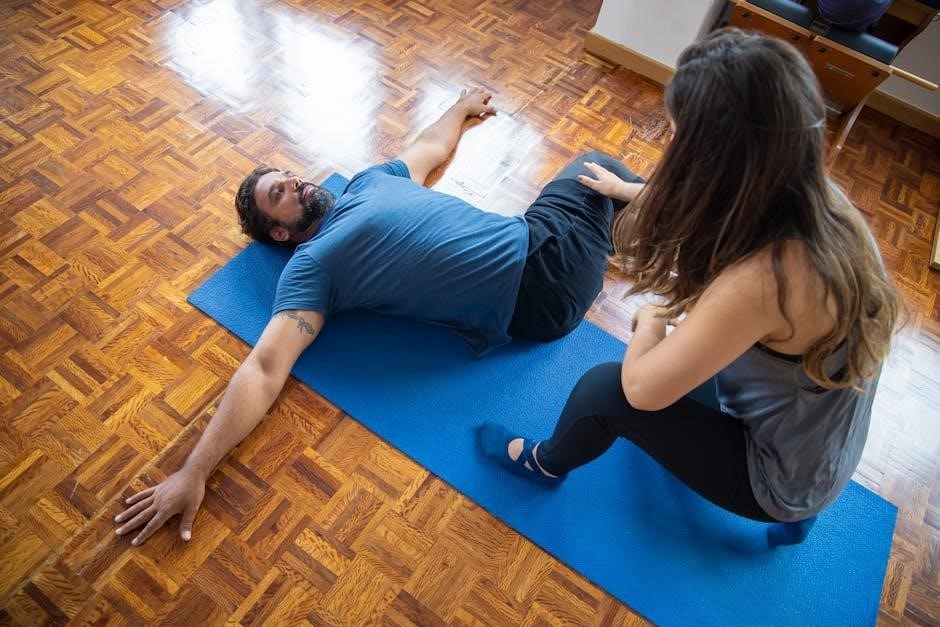
Structure of the 30-Day Workout Program
This program offers a balanced approach with weekly progression‚ incorporating strength training‚ cardio‚ and rest days. Each week builds on the last‚ ensuring gradual fitness improvement and sustainability.
Weekly Breakdown: Progression and Intensity
The program is divided into four weeks‚ each designed to gradually increase in intensity and difficulty. Week 1 focuses on foundational movements like push-ups‚ squats‚ and planks‚ building a base level of fitness. Week 2 introduces more challenging exercises and full-body circuits‚ while Week 3 emphasizes endurance with cardio-driven workouts. The final week pushes you to your limits with high-intensity sessions and functional training. Each week builds on the previous one‚ ensuring continuous progress and adaptation. This structured approach helps prevent plateaus and keeps the workouts engaging and effective for all fitness levels.
Understanding the Importance of Rest Days
Rest days are a crucial component of the 30-day no-equipment workout program‚ allowing your body to recover and rebuild muscle tissue. Without adequate rest‚ you risk overtraining‚ which can lead to injuries or burnout. Rest days help your body adapt to the demands of exercise‚ ensuring continuous progress and improved performance. They also give your mind a chance to recharge‚ maintaining motivation and focus throughout the program.
The program incorporates rest days strategically‚ balancing intense workouts with periods of recovery. This approach promotes long-term fitness gains and overall well-being‚ making it sustainable and effective for all participants.
Combining Strength Training and Cardio
This 30-day program seamlessly integrates strength training and cardio to maximize fitness gains. Bodyweight exercises like push-ups‚ squats‚ and lunges build muscle‚ while cardio activities such as jump squats‚ planks‚ and running in place improve heart health and burn calories. Combining these elements ensures a well-rounded workout that targets all major muscle groups and enhances cardiovascular endurance. This dual approach not only accelerates fat loss but also improves overall physical fitness. By alternating between strength-focused days and cardio-intensive sessions‚ the program ensures balanced progression‚ helping you achieve a stronger‚ leaner‚ and more energetic physique within the month.
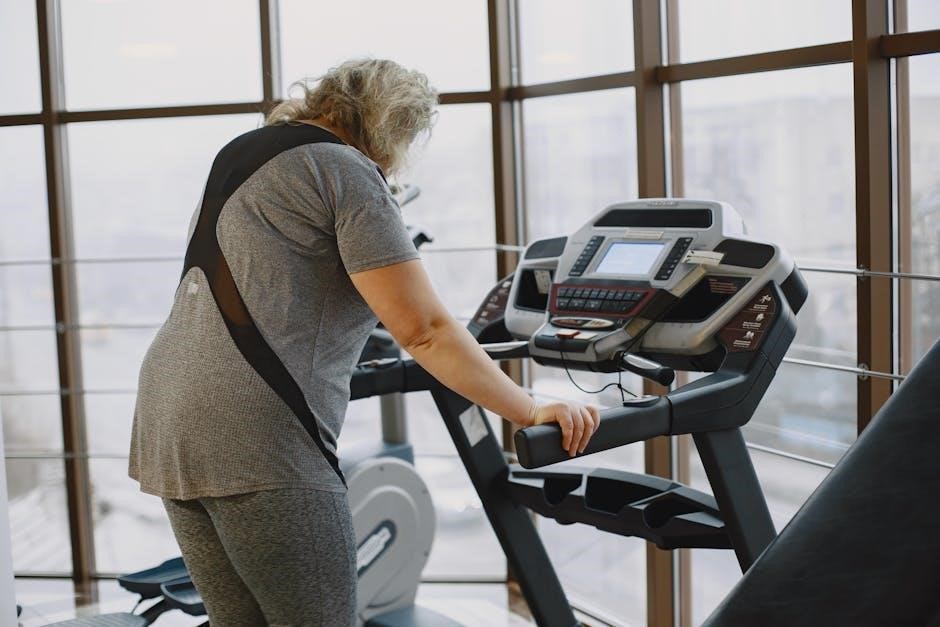
Week 1: Building a Foundation
Week 1 focuses on basic bodyweight exercises like push-ups‚ squats‚ and planks to build foundational strength and endurance. It introduces HIIT for cardio and includes rest days for recovery‚ ensuring a gradual and sustainable start to your fitness journey.
Day 1-3: Basic Bodyweight Exercises
Days 1-3 introduce foundational bodyweight exercises to build strength and endurance. Start with push-ups‚ squats‚ lunges‚ planks‚ and glute bridges‚ focusing on proper form to prevent injury. These exercises target major muscle groups‚ improving overall fitness. Perform 3 sets of 10-15 reps for each exercise‚ resting briefly between sets. This phase establishes a routine‚ making it easier to progress. Consistency is key‚ as these exercises lay the groundwork for more intense workouts in later weeks. By mastering these basics‚ you’ll build confidence and a strong foundation for the rest of the program. Keep track of your progress to stay motivated and ensure steady improvement throughout the week.
Days 4-5 introduce HIIT‚ a high-intensity interval training method that boosts cardiovascular fitness and burns fat efficiently. HIIT involves short bursts of intense exercise followed by brief rest periods. Examples include sprinting in place‚ burpees‚ jump squats‚ and mountain climbers. Perform 3-4 rounds of 30 seconds of intense effort followed by 30 seconds of rest. HIIT sessions are shorter but more intense than traditional workouts‚ making them ideal for time efficiency. This phase accelerates heart rate‚ enhances endurance‚ and increases metabolism. Stay focused‚ push through the intensity‚ and use these days to challenge your limits while building stamina and mental resilience. HIIT is a cornerstone of this program‚ driving rapid improvements in fitness levels. Embrace the challenge and see results quickly.
Day 6-7: Rest and Active Recovery
Days 6-7 are dedicated to rest and active recovery‚ allowing your body to heal and rebuild. This period is crucial for muscle repair and mental rejuvenation. Engage in light activities like stretching‚ yoga‚ or leisurely walks to promote blood flow without overexertion. Avoid high-intensity exercises to prevent burnout and injury. Use this time to reflect on your progress‚ plan meals‚ and prepare for the upcoming week. Active recovery helps maintain mobility while giving your muscles the rest they need to grow stronger. Embrace these days as an essential part of your fitness journey‚ ensuring you return to your workouts refreshed and ready to push harder. Rest is not a step backward but a strategic move forward in your transformation.
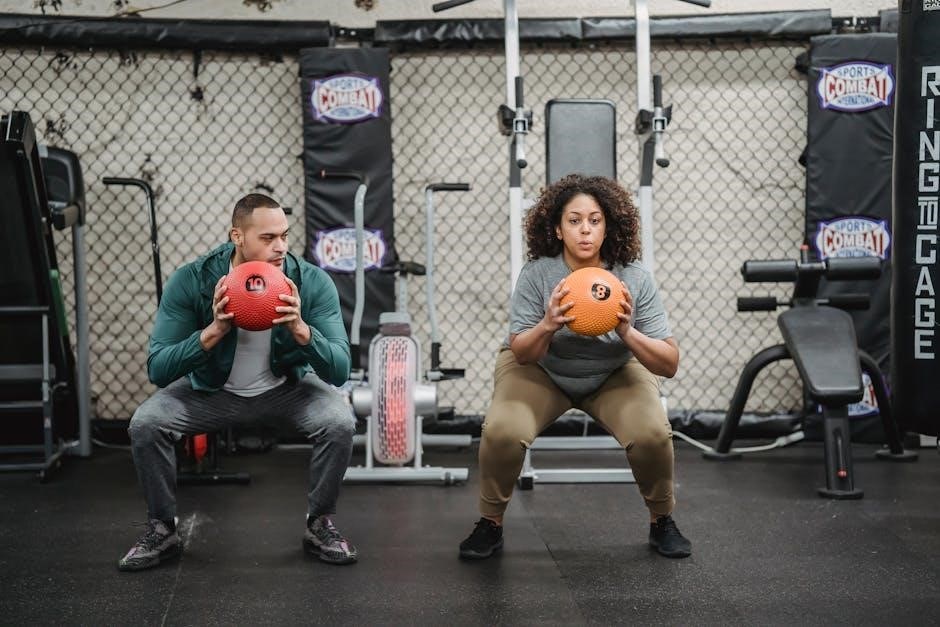
Week 2: Increasing Intensity
Week 2 focuses on advancing your fitness level with more challenging exercises and circuit training. This phase builds on the foundation established in Week 1‚ ensuring continuous progress and engagement while maintaining a balanced approach to avoid overtraining.
Day 8-10: Advanced Bodyweight Exercises
Days 8-10 introduce advanced bodyweight exercises to challenge your strength and endurance. These workouts include single-leg squats‚ plyo push-ups‚ and glute bridges. Each exercise targets specific muscle groups‚ building on the foundation established in Week 1. The increased intensity helps improve balance‚ coordination‚ and overall physical fitness. By incorporating variations and progressions‚ you’ll continue to see noticeable improvements in strength and muscle tone. This phase prepares your body for the more demanding workouts ahead‚ ensuring you stay motivated and engaged throughout the program.
Day 11-12: Full-Body Circuit Training
Days 11-12 focus on full-body circuit training‚ combining a series of exercises to maximize calorie burn and muscle engagement. These workouts include burpees‚ jump squats‚ mountain climbers‚ and plank variations‚ performed in quick succession with minimal rest. Circuit training boosts cardiovascular fitness‚ enhances muscular endurance‚ and accelerates fat loss. The dynamic nature of these workouts keeps you engaged while challenging your body to adapt to increasing demands. By the end of Day 12‚ you’ll notice improvements in stamina and overall physical performance‚ setting a strong foundation for the next phase of the program.
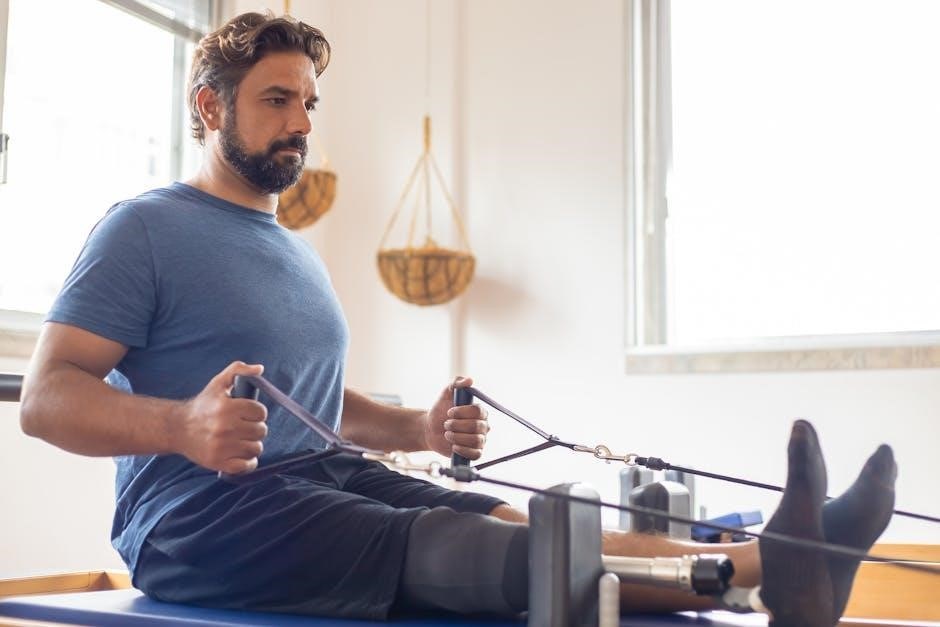
Day 13-14: Rest and Mobility Work
Days 13-14 are dedicated to rest and mobility work‚ allowing your body to recover and rebuild. These days are crucial for muscle repair and preventing injury. Engage in light activities like stretching‚ yoga‚ or foam rolling to improve flexibility and reduce muscle tension. Active recovery‚ such as a short walk or gentle movements‚ can also be beneficial. Use this time to recharge mentally and physically‚ ensuring you’re prepared for the upcoming challenges. Proper rest and mobility work enhance overall performance and support long-term progress in your fitness journey.

Week 3: Focusing on Endurance
Week 3 emphasizes building endurance with cardio-driven workouts and strength exercises‚ helping you enhance stamina and overall fitness without any equipment.
Day 15-17: Cardio-Driven Workouts
Days 15-17 focus on cardio-driven workouts to boost endurance and stamina. These sessions include high-intensity interval training (HIIT)‚ bodyweight exercises like jumping jacks‚ burpees‚ and mountain climbers. The goal is to elevate your heart rate and sustain it for longer periods‚ improving cardiovascular health. Each workout is structured with a 5-minute warm-up‚ followed by 20-25 minutes of intense intervals‚ and ends with a 5-minute cool-down; Consistency is key to seeing improvements in endurance. Track your progress by increasing the duration or intensity of your workouts. These cardio-focused days will leave you feeling more energetic and prepared for the final week of the program.
Day 18-19: Strength and Stability Exercises
Days 18-19 focus on building strength and stability through targeted bodyweight exercises. These workouts emphasize core stability‚ balance‚ and functional strength. Exercises include advanced variations of push-ups‚ squats‚ lunges‚ and planks‚ designed to challenge your muscles and improve posture. Stability work helps prevent injuries and enhances overall athleticism. Incorporate progressive overload by increasing reps or intensity. These sessions also include dynamic movements to improve coordination and mobility. By focusing on proper form and control‚ you’ll build a stronger foundation for everyday activities and future workouts. These days are crucial for reinforcing muscle endurance and preparing your body for the final push in the program.
Day 20-21: Rest and Recovery Techniques
Days 20-21 are dedicated to rest and recovery‚ allowing your body to heal and adapt. These days are crucial for avoiding burnout and preventing injuries. Engage in light activities like stretching‚ yoga‚ or leisurely walks to promote blood flow without overexertion. Incorporate foam rolling or self-myofascial release to relieve muscle tension. Prioritize hydration by drinking plenty of water and focus on nutrient-dense meals to support recovery. Aim for 7-9 hours of quality sleep to aid muscle repair and mental rejuvenation. Use this time to reflect on your progress and mentally prepare for the final week of the program. Active recovery ensures you return stronger and more motivated for the remaining days.

Week 4: Final Push and Progression
Week 4 intensifies your workouts with high-energy exercises‚ focusing on core strength and full-body challenges. Push your limits‚ refine your form‚ and celebrate your progress with confidence.
Day 22-24: High-Intensity Full-Body Workouts
These final high-intensity days push your body to its limits‚ combining advanced bodyweight exercises with cardio bursts. Expect intense circuits like burpees‚ jump squats‚ and mountain climbers to boost cardiovascular fitness and muscle endurance. Each workout includes AMRAP (As Many Rounds As Possible) sets to challenge your stamina and strength. Core-intensive exercises like plank variations and Russian twists are emphasized to strengthen your midsection. By this phase‚ you’ll notice significant improvements in your endurance and overall physique. Stay focused‚ track your progress‚ and give your all to these workouts to maximize results and celebrate your transformation by the end of the program.
Day 25-27: Core and Functional Training
These days focus on strengthening your core and improving functional movement. Workouts include exercises like planks‚ Russian twists‚ and leg raises to target abdominal muscles. Functional training involves dynamic movements such as bird dogs‚ single-leg squats‚ and lateral lunges to enhance balance and coordination. Sessions may include core circuits and bodyweight exercises that mimic daily actions‚ improving overall stability and reducing injury risk. The emphasis is on precision and control‚ with minimal rest between sets to maximize engagement. By improving core strength and functional fitness‚ you’ll enhance your posture‚ balance‚ and ability to perform daily tasks with ease. These workouts prepare your body for long-term health and vitality.
Day 28-30: Final Assessments and Celebrations
These final days are dedicated to evaluating your progress and celebrating your achievements. Conduct a fitness assessment by repeating initial tests like push-ups‚ squats‚ and planks to measure improvements. Reflect on how far you’ve come physically and mentally. Celebrate your success with non-scale victories‚ such as increased energy or better overall well-being. Use this time to plan your next steps‚ whether continuing with advanced workouts or maintaining your new habits. Reward yourself for your dedication and hard work‚ knowing you’ve built a strong foundation for a healthier lifestyle. This milestone marks the end of the program but the beginning of your long-term fitness journey.
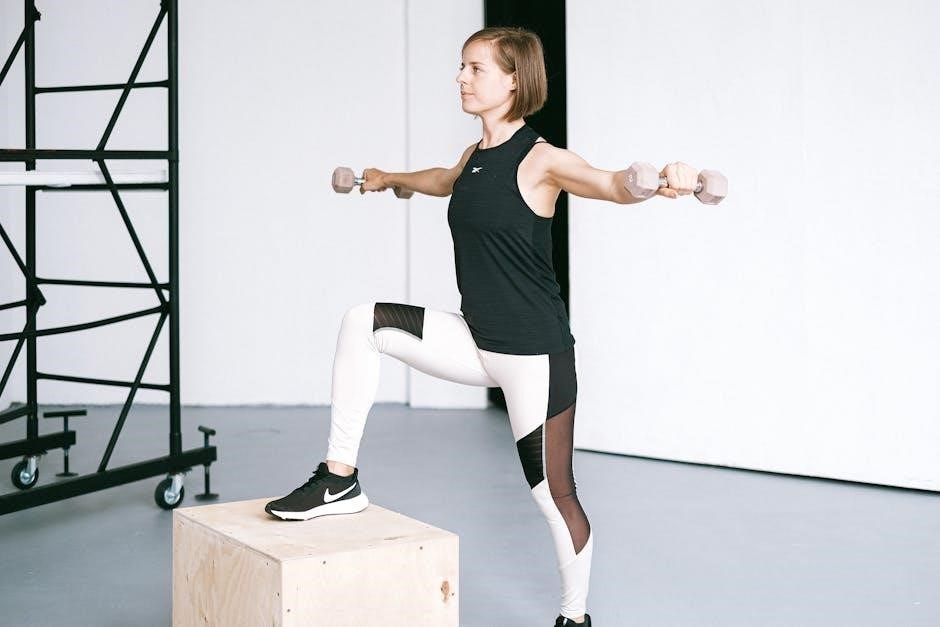
Nutrition and Recovery Tips
Nutrition and recovery are crucial for maximizing results. Focus on a balanced diet rich in proteins‚ carbs‚ and healthy fats to fuel workouts and aid muscle repair. Stay hydrated‚ prioritize sleep‚ and incorporate rest days to optimize recovery. Proper nutrition and recovery strategies will enhance performance‚ prevent injury‚ and support overall fitness goals throughout the 30-day program.
The Role of Diet in Supporting Your Workout
A well-balanced diet is essential for fueling your workouts and supporting muscle recovery. Focus on consuming lean proteins like chicken‚ fish‚ and legumes to repair and build muscle tissue. Complex carbohydrates‚ such as whole grains and vegetables‚ provide sustained energy for workouts. Healthy fats‚ including avocados and nuts‚ aid in hormone production and overall health. Aim to eat meals rich in fiber and avoid processed foods to maintain optimal energy levels. Staying hydrated is also critical‚ as water supports digestion‚ energy‚ and recovery. Consider meal prepping to ensure consistency and portion control. Additionally‚ supplements like protein powder or multivitamins can help fill nutritional gaps‚ but whole foods should always be your primary source. A structured diet plan complements your workout routine‚ ensuring you perform at your best and see noticeable results by the end of the 30-day program.
Best Practices for Post-Workout Recovery
Proper recovery after workouts is crucial for muscle repair and overall progress. Begin with stretching or foam rolling to improve flexibility and reduce muscle tension. Rehydrate with water or electrolyte-rich beverages to replenish lost fluids. Consume a balanced meal or snack with protein and carbohydrates within 30-60 minutes post-workout to aid muscle recovery. Prioritize rest days to allow your body time to heal and rebuild. Aim for 7-9 hours of quality sleep nightly‚ as this is when your body repairs and strengthens muscles. Incorporate light activities like walking or yoga on rest days to promote blood flow without overexertion; Consistent recovery practices will enhance your workout results and support long-term fitness goals.
Hydration and Sleep: Key Factors for Success
Hydration and sleep are essential for optimal performance and recovery in your 30-day workout program. Drinking plenty of water ensures proper bodily functions‚ muscle recovery‚ and energy levels. Aim for at least 8-10 glasses of water daily‚ adjusting for sweat loss during intense sessions. Sleep plays a critical role in muscle repair and mental rejuvenation. Prioritize 7-9 hours of quality sleep each night to support physical recovery and prevent fatigue. Establish a consistent bedtime routine and avoid screens before bed to improve sleep quality. Proper hydration and sleep habits will enhance your workout results and keep you motivated throughout the program.
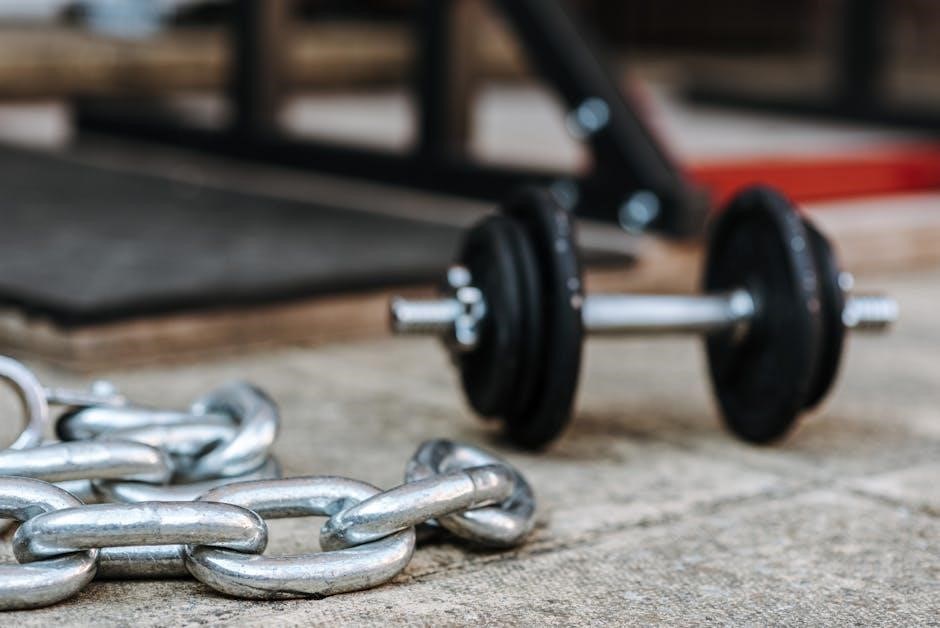
Tracking Progress and Staying Accountable
Tracking your workouts and progress is crucial for staying motivated. Use a journal or app to log exercises‚ set reminders‚ and monitor improvements daily‚ ensuring consistent effort and visible results.
How to Measure Fitness Improvements
Measuring fitness improvements in a 30-day no-equipment program involves tracking progress through reps‚ time‚ and overall performance. Start by logging your workouts‚ noting the number of reps and sets completed. Take progress photos and measurements weekly to observe physical changes. Use a journal to record how workouts feel—increased energy‚ faster completion times‚ or reduced fatigue are signs of improvement. Additionally‚ assess your ability to perform more challenging exercises over time. Celebrate non-scale victories‚ like better endurance or stronger core stability. Consistency is key; by the end of the program‚ you’ll see measurable gains in strength‚ endurance‚ and overall fitness.
Using a Workout Journal for Accountability
A workout journal is a powerful tool for staying accountable during your 30-day no-equipment program. By writing down each workout‚ you can track your progress‚ set achievable goals‚ and stay motivated. Note the exercises performed‚ reps completed‚ and any challenges faced. This helps identify improvements over time and keeps you committed to the plan. Many free PDF guides include space for journaling‚ making it easier to monitor your journey. Celebrate milestones‚ no matter how small‚ to maintain motivation. Consistency is key‚ and a journal ensures you stay on track‚ providing a clear record of your fitness journey and helping you push through setbacks.
Sharing Your Journey on Social Media
Sharing your 30-day workout journey on social media can boost accountability and motivation. Post daily updates‚ progress photos‚ or workout highlights using relevant hashtags like #NoEquipmentWorkout or #30DayChallenge. Many free PDF guides offer tips for documenting your journey online. Engage with fitness communities to gain support and inspiration. Platforms like YouTube and Instagram are great for discovering workout videos and connecting with others. Sharing your achievements can also inspire others and keep you committed to your goals. Plus‚ tracking your progress visually can help you see improvements and stay motivated throughout the program.
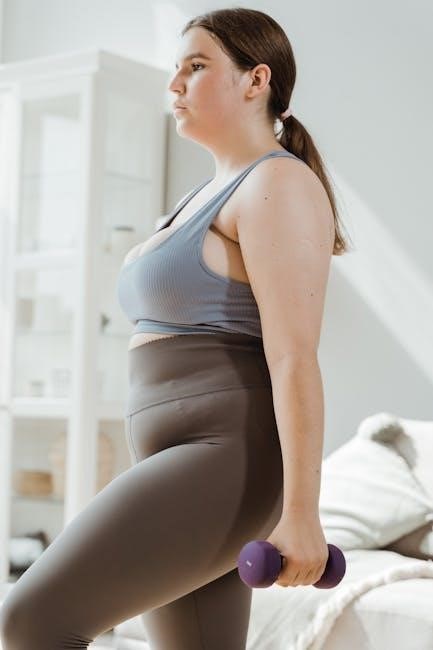
Common Challenges and Solutions
Overcome common challenges like lack of motivation‚ muscle soreness‚ and difficulty adjusting workouts. Stay consistent‚ incorporate rest days‚ and modify exercises to suit your fitness level. Success awaits!
Overcoming Lack of Motivation
Staying motivated during a 30-day workout program can be challenging‚ but setting clear goals and celebrating small milestones helps maintain focus. Create a workout schedule and track progress in a journal to visualize improvements. Find a workout buddy or share your journey on social media for accountability. Reward yourself after reaching key milestones‚ like completing a week of workouts. Remember‚ consistency is key‚ and every workout brings you closer to your fitness goals. Stay positive‚ and remind yourself why you started. Motivation grows with small wins‚ so embrace the process and celebrate your efforts daily.
Dealing with Muscle Soreness and Fatigue
Muscle soreness and fatigue are common during a 30-day workout program‚ especially in the early stages. Ensure adequate rest days as outlined in the plan to allow your body to recover. Incorporate light stretching or yoga on rest days to alleviate soreness. Stay hydrated‚ as water plays a crucial role in muscle recovery. Proper nutrition‚ including protein-rich foods‚ helps repair and rebuild muscles. Prioritize sleep‚ as it is essential for physical recovery and energy replenishment. Gentle foam rolling or massage can also reduce muscle tension. Remember‚ soreness is temporary and decreases as your body adapts. Listen to your body and adjust intensity if needed‚ but maintain consistency to progress.
Adjusting the Plan for Different Fitness Levels
The 30-day no-equipment workout program is versatile and can be tailored to suit various fitness levels. For beginners‚ exercises like push-ups can be modified to knee push-ups‚ and planks can be shorter in duration. Intermediate individuals can increase reps or intensity‚ while advanced participants might try single-leg squats or plyometric moves. The plan’s progression ensures steady challenges for all levels‚ starting with basic squats and advancing to jump or sumo squats. Incorporating different tempos or pauses‚ like slower lowers in squats‚ can enhance difficulty without equipment. Encourage participants to listen to their bodies‚ ensuring safety and manageability to avoid injuries. Provide specific modifications for each level‚ such as modified push-ups for beginners and decline push-ups for advanced users. Focus on tracking progress appropriately for each group‚ emphasizing completion for beginners‚ increased reps for intermediates‚ and mastering complex moves for advanced individuals. This scalable approach ensures effectiveness for all‚ promoting consistent progress and engagement.
Completing the 30-day no-equipment workout program is a significant achievement. Celebrate your progress and consider transitioning to advanced routines or maintaining a healthy lifestyle for long-term success.
The Importance of Consistency Beyond 30 Days
Consistency is key to sustaining fitness gains after completing the 30-day program. Regular exercise helps maintain muscle tone‚ cardiovascular health‚ and mental well-being. Incorporate physical activity into your daily routine‚ even if it’s just 20-30 minutes a day. Setting realistic goals and tracking progress can help maintain motivation. Over time‚ gradually increase the intensity or explore new workout styles to avoid plateaus. Remember‚ fitness is a lifelong journey‚ and consistency ensures long-term success and overall health.
Transitioning to More Advanced Workouts
After completing the 30-day program‚ you can progress to more advanced workouts by increasing intensity‚ duration‚ or complexity. Gradually introduce weighted exercises or resistance bands to challenge muscles further. Incorporate more dynamic movements‚ such as plyometrics or advanced calisthenics‚ to enhance power and agility. Consider following structured plans like the r/bodyweightfitness routine or exploring specialized training methods. Continuously challenge yourself to avoid plateaus and achieve continued growth. Remember‚ progression is gradual‚ so focus on mastering each step before advancing.
Maintaining a Healthy Lifestyle Post-Program
Maintaining a healthy lifestyle after completing the 30-day program requires consistent effort and mindful habits. Focus on balanced nutrition by prioritizing whole foods‚ lean proteins‚ and hydration to fuel your body. Incorporate regular physical activity‚ even if it’s just 20-30 minutes daily‚ to sustain fitness gains. Ensure adequate sleep and stress management to support recovery and overall well-being. Stay motivated by setting new fitness goals or exploring new workout styles‚ such as yoga or running. Building a strong support system‚ like joining fitness communities or sharing progress on social media‚ can also help maintain accountability. Remember‚ consistency is key to long-term success and a healthier‚ stronger you.
